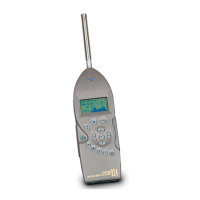9/29/09 D-3
midnight. The levels for the hourly periods between 7 p.m.
and 10 p.m. have 5 added to them to represent a lessened
tolerance for noise during evening activities. They are
energy summed and converted to an average noise exposure
rating.
Criterion Duration (T
c
) It is the time required for a constant sound level equal to the
Criterion Level to produce a Noise Dose of 100%. Criterion
Duration is typically 8 hours.
Example: If the Criterion Level = 90 dB and the Criterion
Duration is 8 hours, then a sound level of 90 dB for 8 hours,
will produce a 100% Noise Dose. See Noise Dose.
Standard:
ANSI S12.19
Criterion Sound Exposure
(CSE)
The product of the Criterion Duration and the mean square
sound pressure associated with the Criterion Sound Level
when adjusted for the Exchange Rate. It is expressed in
Pascals-squared seconds when the exchange rate is 3 dB.
where q is the Exchange Rate Factor. See Exchange Rate.
Standard: ANSI S1.25
Criterion Sound Level (L
c
) It is the sound level which if continually applied for the
Criterion Duration will produce a Noise Dose of 100%. The
current OSHA Criterion Level is 90 dB.
Standard: ANSI S12.19
Daily Personal Noise Exposure
(
LEP,d
)
It is the level of a constant sound over the Criterion Duration
that contains the same sound energy as the actual, unsteady
sound over a specific period. The period is generally shorter,
so the sound energy is spread out over the Criterion Duration
period.
Example: If the Criterion Duration = 8 hours and the specific
period is 4 hours and the average level during the 4 hours is
86 dB, then the L
EP,d
= 83 dB.
Day-Night Average Sound
Level (DNL, L
dn
)
A rating of community noise exposure to all sources of sound that differentiates between daytime and
nighttime noise exposure. The equation for it is

